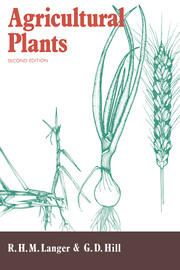Book contents
- Frontmatter
- Contents
- Preface to the first edition
- Preface to the second edition
- 1 World population and crop production
- 2 Plant structure
- 3 Liliaceae
- 4 Poaceae
- 5 Apiaceae
- 6 Asteraceae
- 7 Brassicaceae
- 8 Cannabinaceae
- 9 Chenopodiaceae
- 10 Cucurbitaceae
- 11 Fabaceae
- 12 Lamiaceae
- 13 Linaceae
- 14 Malvaceae
- 15 Papaveraceae
- 16 Solanaceae
- 17 Physiological basis of yield
- Index of specific names
- Subject index
4 - Poaceae
Published online by Cambridge University Press: 05 June 2012
- Frontmatter
- Contents
- Preface to the first edition
- Preface to the second edition
- 1 World population and crop production
- 2 Plant structure
- 3 Liliaceae
- 4 Poaceae
- 5 Apiaceae
- 6 Asteraceae
- 7 Brassicaceae
- 8 Cannabinaceae
- 9 Chenopodiaceae
- 10 Cucurbitaceae
- 11 Fabaceae
- 12 Lamiaceae
- 13 Linaceae
- 14 Malvaceae
- 15 Papaveraceae
- 16 Solanaceae
- 17 Physiological basis of yield
- Index of specific names
- Subject index
Summary
The Poaceae (Gramineae), the grasses, form one of the largest plant families consisting of some 610 genera and about 10 000 species. Members of this family occur abundantly in every climatic region. On the savannas, prairies, steppes and man-made pastures of the world grasses sustain grazing animals which provide us with milk, butter, cheese, meat, hides and wool. Rice, wheat, millet, and rye form the basis of the daily diet of many millions of people, while other cereals such as maize or barley are also extensively used for livestock production. Cereal grains form the raw material for such alcoholic fermentation products as beer, whisky or saké; maize is a valuable source of oil; sugar from cane is an important commodity on the international market, while other members of the Poaceae like the bamboos are widely used as building material. There can be no doubt that cereals and pasture grasses are economically the most important plants in the world, and it would be quite impossible to imagine how mankind could continue agriculture without them. We thus need to study this family in some detail, first by learning something of its general structure, and later by considering individual species of economic importance.
Grass systematics
In a group of plants with as many genera as the grasses and with such a wide distribution and long evolutionary history it is hardly surprising that classification is not an easy matter. The taxonomy of the Poaceae is a highly specialised study and hardly concerns us here.
- Type
- Chapter
- Information
- Agricultural Plants , pp. 40 - 145Publisher: Cambridge University PressPrint publication year: 1991

